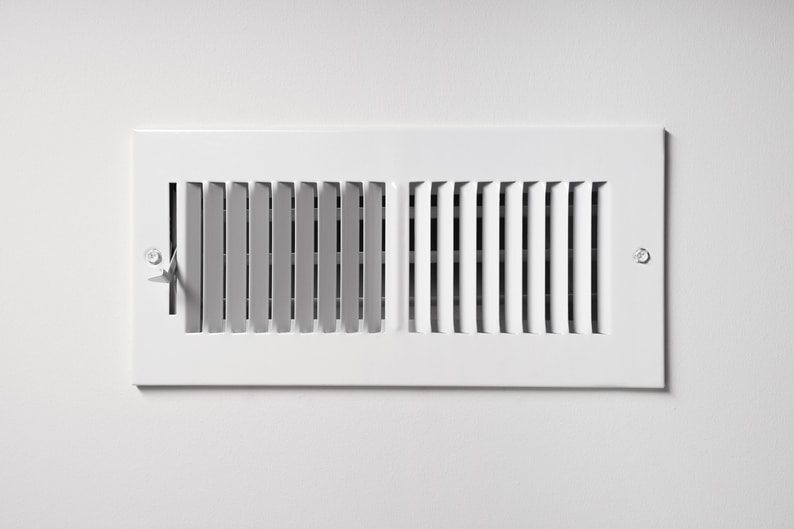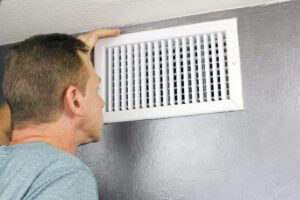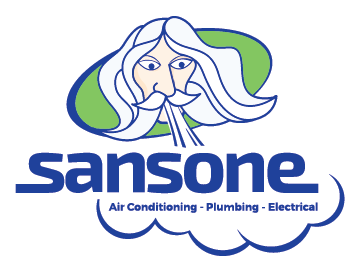
8 Common Causes of Water Dripping From AC Vent
Drip, drip, drip… Uh-oh, did you wake up to water leaking from the AC vent in the ceiling? The most common sign of your AC leaking water is water stains or yellowing on your ceiling near the air vents. This not only can cause damage but doesn’t look good either.
There are many things that can cause water to drip from your AC vent. This isn’t a normal occurrence and should be looked at sooner rather than later. Read on to learn the common causes of water dripping from an AC vent. We’ll also go over what you should do about it. If you still need help, reach out to our experienced air conditioning contractors in West Palm Beach!
1. Air Leaking Around the Vent
The problem: If air is able to escape around the AC vents, rather than flow through the grates as it should, it can cause condensation to build up and drip from the AC vents.
The solution: The easiest thing you can do to fix water leaking from your AC vent is to reach up and feel for any air escaping from around the sides of the air vent. Look for air escaping from anywhere besides the grates.
If air is escaping from anywhere besides the grates, you’re in luck…well, sort of. You can head over to the nearest home improvement store and purchase caulk to seal the leak.
2. Clogged Condensate Drain Line
The problem: If condensation accumulates within the air vent, it can cause water to drip from the AC vents. This is often caused if you have a clogged condensate drain line on your hands.
A clogged condensate drain line can occur for a few reasons, but especially if your air conditioning system is installed in the attic or on an upper level in your home. Sometimes when systems are installed in these areas, problems with the condensate drain can cause water to overflow from the drip pan and into the air ducts or air vents.
The solution: Take a look at the condenser unit (the outdoor component of your AC) and see if the drip pan is overflowing or very full. If so, you are likely dealing with a clogged condensate drain line.
Another sign (and a potentially dangerous one) of a blocked condensate drain is rust on the furnace. Corrosion on your furnace puts it at risk of a serious failure and can be dangerous. If there is rust on your furnace, call an HVAC company immediately.
There are a few different methods for clearing a clogged line, but luckily this is another fix you can perform yourself.
For more information on how to clean your AC drain line, check out our blog: How to Clean Your AC Drain Line in 6 Simple Steps
3. Dirty Air Filter
The problem: A dirty air filter can indirectly cause water to drip from the AC vent in the ceiling by causing the AC to freeze up. As the frost melts – usually after you turn off your AC – the condensation can drain via your AC vents.
The solution: If the frost is minimal, changing the air filter and allowing the unit to return to its normal function can be enough to resolve the problem.
4. Condensation From Uninsulated Ducts
The problem: If your air ducts primarily run through the attic, keep in mind that many attic spaces are not insulated. Poor insulation can cause condensation to build up within your system and drain via the AC vents. If you didn’t put insulation in yourself, don’t assume it’s there.
The solution: Luckily, you can remedy this issue if you have attic access. All you have to do is wrap special air duct insulation around the ductwork.
Start by taking the grate off of your air vents, and examine the problem air vent – is there insulation packed around the vent component in the joist or ceiling space? If there is none, go to the home improvement store and purchase R-11 or R-13 fiberglass batts and pack them around the problem duct boot.
Take the grate off the problem air vent and examine the air duct. Is there insulation packed around the vent component in the joist or ceiling space? If there is no insulation, go to a home improvement store and get R-11 or R-13 fiberglass batts and pack them around the problem duct boot.
5. Broken Sump Pump
The problem: If you’ve already cleaned your condensate drain line and there’s still excess water in the drip pan, then the problem could be your sump pump or condensate pump. Most pumps have a float switch on them that is responsible for turning the pump on when the water reaches a certain level.
The solution: If you see something that looks like a float switch, try manipulating it to test if the pump turns on. Sometimes the float switch can become stuck due to scum or limescale build up. If the switch is working, but not consistently, you can try cleaning the bucket with bleach and removing any build up to see if this improves the performance of your pump.
If you don’t see an easy to identify float switch, look around to see if there is a cable or something attached to pull it up. Once you get it out of the water, you can try to turn it on and see if it’s working – but don’t let it run dry for a significant period of time. If it’s still not turning on, you’ll probably need a new pump. You can attempt to buy a match and swap the pump yourself. You can also schedule an appointment with Sansone and have one of our HVAC professionals fix it for you.
6. Refrigerant Leak
The problem: If you’ve tried troubleshooting the above culprits, your problem could be a refrigerant leak. Generally, there will be less water leaking as a result of a refrigerant leak than a clogged condensate drain. A refrigerant leak causes AC vents to leak water in almost the same way a dirty air filter does. When refrigerant levels are low, your AC unit cannot remove the humidity from the air inside properly. Water that is sucked out of the air can remain on the evaporator coils too long, and freeze over. When it melts, the condensation can drip out of AC vents in the ceiling.
The solution: If you have water dripping from your AC vent combined with low airflow, or air that is not as cool as it should be, there’s a good chance that a refrigerant leak is the problem. Low refrigerant levels are never normal and exposure to refrigerant can be harmful, so it is best to call a licensed HVAC professional to identify and repair the leak.
7. Frozen Evaporator Coil
The problem: Again, when the evaporator coils freeze, the ice can melt when the system is shut off. The resulting condensation can wind up dripping out of the vents and onto your favorite piece of furniture
The solution: Over the course of this article we’ve covered some of the common reasons evaporator coils freeze. If the fixes here did not resolve water leaking from the AC vent in the ceiling, then the issue causing your evaporator coils to freeze will need to be handled by a professional. Take out your air filter, and look inside and (usually) down at the evaporator coils to spot any frost.
8. Roof or Plumbing Leak
The problem: A roof leak or a leak hiding somewhere in your plumbing located above your ductwork can cause the water to travel through your system and out via the AC vents.
The solution: If possible, try to follow the leak to pinpoint its source. If it is a roof or plumbing-related leak, call the appropriate technicians for repairs.
Let Sansone Keep You Cool
It can be scary anytime there’s water leaking inside your home! Luckily, if the water is dripping from your air vent you can most likely repair it yourself! And don’t worry – we’re here to help you at Sansone when you can’t. Call us today or schedule your West Palm Beach AC repair online!

